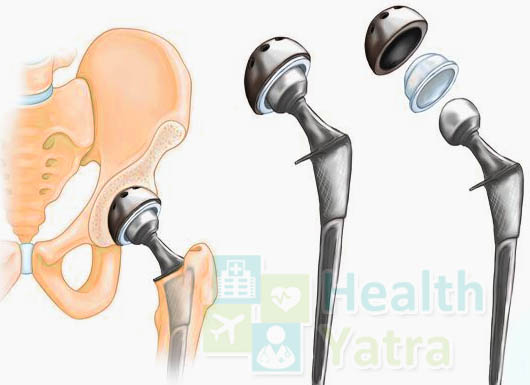What is a Total Hip Replacement Surgery in India?
In a total hip replacement surgery, the painful parts of the damaged hip are replaced with artificial hip parts called prosthesis, a device that substitutes or supplements a joint. The prosthesis consists of steel components: a socket, ball, and stem. The outer shell of the socket is usually made of metal and the inner shell consists of plastic, or the entire socket may be plastic. When the metal ball is joined with the socket, the new hip can allow for smooth, nearly frictionless movement.
Who is Total Hip Replacement Surgery for?
Hip replacement is usually considered once other therapies, such as pain medications, have failed. Most people undergo hip replacement as a result of osteoarthritis of the hip joint. But you might also consider hip replacement if you experience severe pain, loss of motion or deformity of your hip joint. Hip replacement is also used in people with hip injuries, rheumatoid arthritis and other medical conditions, such as a bone tumor or bone loss due to insufficient blood supply (avascular necrosis).
You might want to ask your doctor about the possibility of hip replacement if you frequently experience any of the following:
- Pain that keeps you awake at night
- Little or no relief from pain medications
- Difficulty walking up or down stairs
- Trouble standing from a seated position
- Having to quit activities you enjoy, such as walking, because you’re in too much pain
Hip replacement used to be an option primarily for adults age 60 and above. But improved technology has made strong and longer-lasting artificial joints that are feasible for more active people, including younger people. However, active people face the possibility of another surgery to replace worn out artificial hip joints after 15 or 20 years.
 Types of Total Hip Replacement Surgery:
Types of Total Hip Replacement Surgery:
- Total Hip Replacement
Stem Type with Acrylic Cement Fixation - Total Hip Replacement
Stem Type without Cement Fixation - Total Hip Replacement
Stem Type with Hybrid Fixation - Bearing Materials Used in Joint Replacement
- Metal-on-Metal Bearings
- Ceramic-on-Ceramic Bearings
- Hemi-Surface Replacement for Osteonecrosis
- Surface Replacement of the Hip
What Does Hip Replacement Surgery Involve?
The hip joint is located where the upper end of the femur, or thighbone, meets the pelvis, or hipbone. A ball at the end of the femur, called the femoral head, fits in a socket (the acetabulum) in the pelvis to allow a wide range of motion. During a traditional hip replacement, which lasts from 1 to 2 hours, the surgeon makes a 6- to 8-inch incision over the side of the hip through the muscles and removes the diseased bone tissue and cartilage from the hip joint, while leaving the healthy parts of the joint intact. Then the surgeon replaces the head of the femur and acetabulum with new, artificial parts. The new hip is made of materials that allow a natural gliding motion of the joint.

In recent years, some surgeons have begun performing what is called a minimally invasive, or mini-incision, hip replacement, which requires smaller incisions and a shorter recovery time than traditional hip replacement. Candidates for this type of surgery are usually age 50 or younger, of normal weight based on body mass index, and healthier than candidates for traditional surgery. Joint resurfacing is also being used. Regardless of whether you have traditional or minimally invasive surgery, the parts used to replace the joint are the same and come in two general varieties: cemented and uncemented.
Cemented parts are fastened to existing, healthy bone with a special glue or cement. Hip replacement using these parts is referred to as a “cemented” procedure. Uncemented parts rely on a process called biologic fixation, which holds them in place. This means that the parts are made with a porous surface that allows your own bone to grow into the pores and hold the new parts in place. Sometimes a doctor will use a cemented femur part and uncemented acetabular part. This combination is referred to as a hybrid replacement.
Benefits of Total Hip Replacement
There will be immediate and substantial improvement in your pain, functional status, and overall health-related quality of life following Total Hip Replacement. Promising clinical evidence suggests that these immediate improvements persist in the long term. Over the last two decades, complications associated withTotal Hip Replacement have declined significantly. Prophylactic antibiotic therapy has helped to prevent infection. Use of anticoagulants in the peri-operative period has reduced the incidences of deep venous thrombosis and pulmonary emboli.
Total Hip Replacement Surgery in India:
India is fast becoming the world’s first choice destination for healthcare services – especially orthopaedic surgery. With rapidly expanding infrastructure, clinical expertise and international standard implementation, India is servicing the healthcare needs, at reasonable costs, of international patients from around the world. In recent years many countries have experienced a shortage of specialty care providers, which has restricted their access to quality and cost effective medical care. In sharp contrast India has concentrated on increasing the availability of specialty cares thereby avoiding the shortage of medical professionals. In fact, the availability of clinical expertise, reasonable surgery costs, and internationally trained and educated medical professionals is a major factor in the growth of foreign patient procedures in India. Among modern India’s achievements is its really significant contribution to global healthcare delivery. It is now highly regarded worldwide as a quality provider of medical talent and healthcare delivery.
Resource:
- Hip joint replacement: MedlinePlus Medical Encyclopedia
- Total Hip Arthroplasty Techniques – StatPearls – NCBI Bookshelf
- Hip Replacement Surgery | Johns Hopkins Medicine

